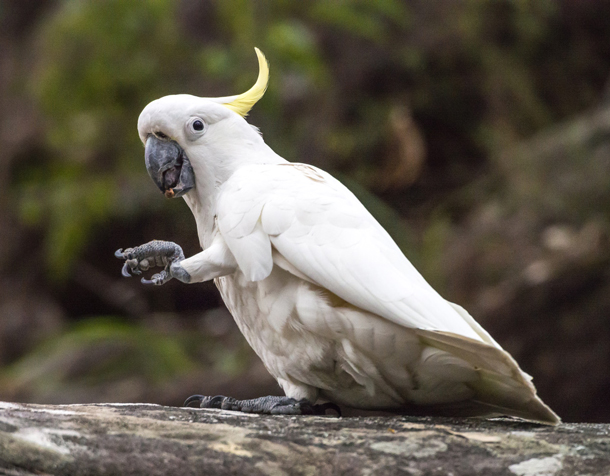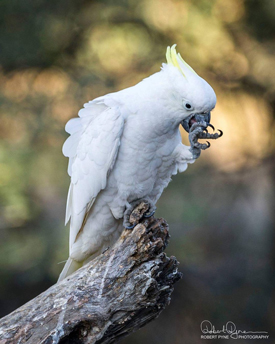BirdNote®: Left Foot or Right? Handedness in Birds
Air Date: Week of February 21, 2020

The sulfur crested cockatoo using its left hand based on the orientation of its vision. (Photo: Simon Tout CC)
More than three quarters of humans are right handed, regardless of culture or where we live in the world. Scientists haven’t really figured out why our species has such a dominance for right handedness but they have found a similar preference in other species. BirdNote®’s Michael Stein reports.
Transcript
CURWOOD: It’s Living on Earth, I’m Steve Curwood.
[BIRDNOTE THEME]
CURWOOD: More than three quarters of humans are right handed, regardless of culture or where we live in the world. Scientists haven’t really figured out why our species has such a dominance for right handedness but they have found a similar preference in other species. BirdNote’s Michael Stein reports.
BirdNote®
Left Foot or Right? Handedness in Birds
Imagine you’re about to shake hands, but with a Sulphur-crested Cockatoo.
[Sulphur-crested Cockatoo calls, https://macaulaylibrary.org/asset/234725, 0.05-.07]
Should you offer your right hand or your left?
You should hold out your left hand. That’s because most Sulphur-crested Cockatoos are left-footed.
[Sulphur-crested Cockatoo calls, https://macaulaylibrary.org/asset/234725, 0.05-.07]
In complex tasks like manipulating a piece of fruit, these intelligent birds work intently with their feet. A parrot’s eyes are located on the sides of its head. So, if it wants to look at something -- say, a delicious piece of fruit -- it has got to cock its head one way or the other do it. And if it looks with its left eye, then uses its left foot.

The sulfur crested cockatoo is a highly intelligent parrot found in Australia, New Guinea, some islands of Indonesia and Puerto Rico. (Photo: Robert Pyne CC)
Scientists call this handedness. That’s when one hand — or foot — is used consistently over the other for doing more complex tasks.
In a study of 16 Australian parrot species scientists found that about half were lefties, a third were righties, and a few were neither.
Handedness, once thought unique to humans, is also seen in chimps and gorillas — mostly righties — and orangutans — mostly lefties, as well as cats and kangaroos.
The evolution of handedness, for righties and lefties alike, improves skill and efficiency in complex tasks—for both parrots and for humans.
###
Written by Bob Sundstrom
Bird sounds provided by The Macaulay Library of Natural Sounds at the Cornell Lab of Ornithology, Ithaca, New York. Recorded by V Powys ML234725.
BirdNote’s theme music was composed and played by Nancy Rumbel and John Kessler.
Producer: John Kessler; Managing Producer: Jason Saul; Associate Producer: Ellen Blackstone
© 2019 Tune In to Nature.org February 2019/2020 Narrator: Michael Stein
ID# handedness-01-2019-02-07 handedness-01
CURWOOD: For pictures of these birds, fly on over to the Living On Earth website, loe.org.
Links
BBC Earth News | “Parrots Prefer Left Handedness”
Living on Earth wants to hear from you!
Living on Earth
62 Calef Highway, Suite 212
Lee, NH 03861
Telephone: 617-287-4121
E-mail: comments@loe.org
Newsletter [Click here]
Donate to Living on Earth!
Living on Earth is an independent media program and relies entirely on contributions from listeners and institutions supporting public service. Please donate now to preserve an independent environmental voice.
NewsletterLiving on Earth offers a weekly delivery of the show's rundown to your mailbox. Sign up for our newsletter today!
 Sailors For The Sea: Be the change you want to sea.
Sailors For The Sea: Be the change you want to sea.
 The Grantham Foundation for the Protection of the Environment: Committed to protecting and improving the health of the global environment.
The Grantham Foundation for the Protection of the Environment: Committed to protecting and improving the health of the global environment.
 Contribute to Living on Earth and receive, as our gift to you, an archival print of one of Mark Seth Lender's extraordinary wildlife photographs. Follow the link to see Mark's current collection of photographs.
Contribute to Living on Earth and receive, as our gift to you, an archival print of one of Mark Seth Lender's extraordinary wildlife photographs. Follow the link to see Mark's current collection of photographs.
 Buy a signed copy of Mark Seth Lender's book Smeagull the Seagull & support Living on Earth
Buy a signed copy of Mark Seth Lender's book Smeagull the Seagull & support Living on Earth

